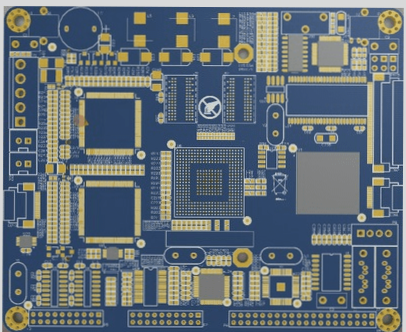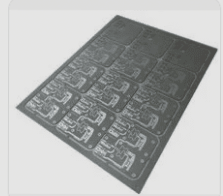The Best PCB Design Method: Six Considerations When Choosing a Component-Based Package
All examples in this article were developed using the Multisim design environment, but these principles apply universally, regardless of the EDA tools used.
1. **Consider the Choice of Component Packaging**
During the schematic design phase, it’s crucial to factor in the component packaging and land pattern choices, which will affect the layout stage. Below are some key considerations when selecting components based on their packaging.
It’s important to remember that the package encompasses both the electrical pad connections and the mechanical dimensions (X, Y, and Z) of the component—this includes the shape of the component body and the pins that interface with the PCB. When selecting components, consider any mounting or packaging constraints that might affect both the top and bottom layers of the final PCB. Certain components (e.g., polar capacitors) may have significant height restrictions that need to be accounted for in the selection process.
At the start of the design, it’s helpful to outline a basic PCB frame shape and position larger or critical components (such as connectors). This allows for an intuitive, quick visual of the circuit board in its “virtual” state (without wiring), giving you a clearer sense of the relative positioning and height of both the PCB and its components. This approach will ensure that components fit properly within the final enclosure (e.g., plastic casing, chassis) once the PCB is assembled. You can also use the 3D preview mode from the Tools menu to examine the entire circuit board layout.
The land pattern defines the actual shape of the pads or vias where the components will be soldered to the PCB. These copper patterns provide essential information about the component’s footprint. The size and accuracy of the land pattern are crucial for proper soldering, as well as the mechanical and thermal reliability of the connected components.
When designing the PCB layout, it’s important to consider how the board will be manufactured and how the pads will be soldered, especially if manual soldering is required. Reflow soldering, which involves melting flux in a controlled high-temperature furnace, is suitable for a wide range of surface mount devices (SMDs). Wave soldering is typically used to solder the reverse side of the PCB for through-hole components but can also be used for some SMDs placed on the back of the board. When using wave soldering, bottom-side surface mount devices usually need to be oriented in a specific direction, and the pads may require modification to accommodate this soldering method.

1. **Component Selection Flexibility**
The selection of components can evolve during the design process. Deciding early which devices should use plated through holes (PTH) versus surface mount technology (SMT) will help streamline the PCB layout and overall planning. Key factors to consider include cost, availability, device area density, and power consumption. From a manufacturing perspective, surface-mount devices are generally less expensive and have better availability compared to through-hole devices. For small to medium-scale prototype projects, it is typically recommended to choose larger surface-mount devices or through-hole components, as these are easier to solder manually and facilitate better pad and signal connections during troubleshooting and debugging.
If a suitable package is unavailable in the database, a custom package should typically be created in the design tool.
2. **Implement a Proper Grounding Strategy**
Ensure the design includes sufficient bypass capacitors and ground planes. When using integrated circuits, it’s critical to place an appropriate decoupling capacitor close to the power pins and ground (preferably a ground plane). The capacitor’s value depends on the specific application, capacitor technology, and operating frequency. Proper placement of the bypass capacitor between the power and ground pins, as close as possible to the relevant IC pins, will enhance the circuit’s electromagnetic compatibility (EMC) and susceptibility.
3. **Manage Virtual Component Packages**
Generate a Bill of Materials (BOM) to verify the virtual components in your design. Virtual components do not have associated packaging and will not be transferred to the layout stage. The BOM should highlight all virtual components. Typically, these are power and ground signals, which are considered virtual components processed only in the schematic environment and excluded from the layout design. Unless intended for simulation purposes, virtual components should be replaced with encapsulated components.
4. **Ensure Complete BOM Data**
Review the BOM carefully to ensure all component data is complete. After generating the BOM, carefully verify that all entries include accurate device, supplier, and manufacturer information. Incomplete data should be filled in to avoid errors later in the design or manufacturing process.
5. **Organize BOM by Component Label**
For easier sorting and viewing of the BOM, ensure that component numbers are listed in sequential order. This organization will simplify the review and modification of the BOM.
6. **Inspect for Redundant Gate Circuits**
In PCB design, all redundant gate inputs should be properly connected to avoid floating input pins. It’s important to check for any redundant or missing gate circuits, ensuring that all input pins are fully connected. If an input terminal is left floating, it could prevent the system from operating correctly. For example, with dual op-amps, if only one op-amp is used from a dual-package IC, the unused op-amp should either be used in the design or its input should be grounded, with a suitable feedback network (e.g., unity gain or other gain settings) deployed to ensure proper operation.
In some cases, ICs with floating pins may not function correctly within specified operating conditions. Typically, this occurs when inputs or outputs are close to or within the component’s power rail, and the IC or other gates in the same device are not in a saturated state. This behavior is often missed in simulations, as models typically do not simulate the effect of floating pins or the interaction between multiple parts of the IC.
All examples in this article were developed using the Multisim design environment, but these principles apply universally, regardless of the EDA tools used.
1. **Consider the Choice of Component Packaging**
During the schematic design phase, it’s crucial to factor in the component packaging and land pattern choices, which will affect the layout stage. Below are some key considerations when selecting components based on their packaging.
It’s important to remember that the package encompasses both the electrical pad connections and the mechanical dimensions (X, Y, and Z) of the component—this includes the shape of the component body and the pins that interface with the PCB. When selecting components, consider any mounting or packaging constraints that might affect both the top and bottom layers of the final PCB. Certain components (e.g., polar capacitors) may have significant height restrictions that need to be accounted for in the selection process.
At the start of the design, it’s helpful to outline a basic PCB frame shape and position larger or critical components (such as connectors). This allows for an intuitive, quick visual of the circuit board in its “virtual” state (without wiring), giving you a clearer sense of the relative positioning and height of both the PCB and its components. This approach will ensure that components fit properly within the final enclosure (e.g., plastic casing, chassis) once the PCB is assembled. You can also use the 3D preview mode from the Tools menu to examine the entire circuit board layout.
The land pattern defines the actual shape of the pads or vias where the components will be soldered to the PCB. These copper patterns provide essential information about the component’s footprint. The size and accuracy of the land pattern are crucial for proper soldering, as well as the mechanical and thermal reliability of the connected components.
When designing the PCB layout, it’s important to consider how the board will be manufactured and how the pads will be soldered, especially if manual soldering is required. Reflow soldering, which involves melting flux in a controlled high-temperature furnace, is suitable for a wide range of surface mount devices (SMDs). Wave soldering is typically used to solder the reverse side of the PCB for through-hole components but can also be used for some SMDs placed on the back of the board. When using wave soldering, bottom-side surface mount devices usually need to be oriented in a specific direction, and the pads may require modification to accommodate this soldering method.

1. **Component Selection Flexibility**
The selection of components can evolve during the design process. Deciding early which devices should use plated through holes (PTH) versus surface mount technology (SMT) will help streamline the PCB layout and overall planning. Key factors to consider include cost, availability, device area density, and power consumption. From a manufacturing perspective, surface-mount devices are generally less expensive and have better availability compared to through-hole devices. For small to medium-scale prototype projects, it is typically recommended to choose larger surface-mount devices or through-hole components, as these are easier to solder manually and facilitate better pad and signal connections during troubleshooting and debugging.
If a suitable package is unavailable in the database, a custom package should typically be created in the design tool.
2. **Implement a Proper Grounding Strategy**
Ensure the design includes sufficient bypass capacitors and ground planes. When using integrated circuits, it’s critical to place an appropriate decoupling capacitor close to the power pins and ground (preferably a ground plane). The capacitor’s value depends on the specific application, capacitor technology, and operating frequency. Proper placement of the bypass capacitor between the power and ground pins, as close as possible to the relevant IC pins, will enhance the circuit’s electromagnetic compatibility (EMC) and susceptibility.
3. **Manage Virtual Component Packages**
Generate a Bill of Materials (BOM) to verify the virtual components in your design. Virtual components do not have associated packaging and will not be transferred to the layout stage. The BOM should highlight all virtual components. Typically, these are power and ground signals, which are considered virtual components processed only in the schematic environment and excluded from the layout design. Unless intended for simulation purposes, virtual components should be replaced with encapsulated components.
4. **Ensure Complete BOM Data**
Review the BOM carefully to ensure all component data is complete. After generating the BOM, carefully verify that all entries include accurate device, supplier, and manufacturer information. Incomplete data should be filled in to avoid errors later in the design or manufacturing process.
5. **Organize BOM by Component Label**
For easier sorting and viewing of the BOM, ensure that component numbers are listed in sequential order. This organization will simplify the review and modification of the BOM.
6. **Inspect for Redundant Gate Circuits**
In PCB design, all redundant gate inputs should be properly connected to avoid floating input pins. It’s important to check for any redundant or missing gate circuits, ensuring that all input pins are fully connected. If an input terminal is left floating, it could prevent the system from operating correctly. For example, with dual op-amps, if only one op-amp is used from a dual-package IC, the unused op-amp should either be used in the design or its input should be grounded, with a suitable feedback network (e.g., unity gain or other gain settings) deployed to ensure proper operation.
In some cases, ICs with floating pins may not function correctly within specified operating conditions. Typically, this occurs when inputs or outputs are close to or within the component’s power rail, and the IC or other gates in the same device are not in a saturated state. This behavior is often missed in simulations, as models typically do not simulate the effect of floating pins or the interaction between multiple parts of the IC.




